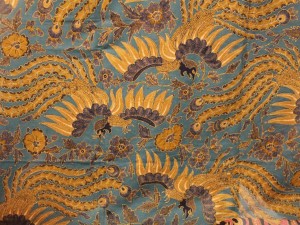
Sawunggaling batik textile by Hardjono Go Tik Swan is one of the pieces of the late Soedjatoen Damais being displayed in the Batik exhibition “Sawunggaling” at Jakarta Textile Museum, Jakarta. ARIEF SUHADIRMAN/JP-ANN
From Solo and Pekalongan in Central Java, Yogyakarta to the northern Java coast and other batik-producing regions in the country, two batik maestros have invented what is known today as Indonesian batik.
People have known Indonesian batik from the variety of motifs, styles and colors that are distinct from one region to another.
Indonesians have the dark-colored Solo batik from Central Java, or Yogyakarta batik that is known for its bright white background, and the intense pattern of the batik from the northern coast with its vivid colors.
But is there any one, true Indonesian batik?
No one really paid attention to the need for one batik style that could unite and sum up these different patterns until one batik maestro appeared and did the job.
In the 1950s, a batik artist from Solo, Hardjono Go Tik Swan, embarked on a quest to find the Indonesian batik. His mission was based on an order from president Sukarno, who wanted to see one nationalized batik character that could differentiate Indonesian batik from others.
It took quite an effort from Hardjono before he finally discovered batik patterns that became national treasures.
These Indonesian batik motifs were adopted from the Javanese traditional batik styles, which Hardjono mixed with bright colors.
He applied yellow, purple, red and green colors to give contrasting background for traditional Solo and Yogya batik patterns, which were associated with dark and gloomy shades.
One of the famous patterns is called Sawunggaling, which describes imaginary birds with magnificent tall feathers that make them look like a cross between a phoenix and peacock.
Hardjono’s inventions became an instant hit among socialites during that time, who fought to make them part of their collections.
More than 50 years later, batik enthusiasts still acknowledge Hardjono’s masterpiece as a legacy for what people refer to as Indonesian batik.
Yet, Hardjono is not alone in promoting Indonesian batik. Indonesia has also the late Iwan Tirta as the great ambassador of Indonesian batik.
From his biography, Iwan is said to have learned much from his predecessor, Hardjono, before bringing batik to a higher level.
Introducing modern techniques with braver and bigger patterns, Iwan has brought Indonesian batik to international fashion stages, where the fabric has become a new favorite.
In attempts to honor the hard work of these two batik maestros, the Jakarta Textile Museum and the cloth and fashion documentation center are organizing a batik exhibition that periodically features Hardjono and Iwan’s batik artwork.
The theme, selected by the organizer for the exhibition, is ‘Sawunggaling’, known as the most outstanding pattern from the two batik designers.
The exhibition runs from May 31 to June 25 and displays 150 batik collections belonging not only to the museum but also to a number of respected batik aficionados, including the wife of Jakarta Governor, Tatiek Fauzi Bowo, the founder of local women’s magazine Femina, Pia Alisyahbana, and former women’s empowerment minister Meutia Hatta.
During the opening ceremony, Tatiek Fauzi Bowo remarked in her speech on the significance of the exhibition to raising the younger generations’ awareness of the role and history of batik in Indonesian culture.
The public has agreed that batik is the new black in today’s society, as we see people wearing the painted fabric in their daily activities.
Batik doesn’t belong just to high-class society anymore, as more and more people use the fabric in their outfits.
The world has even recognized batik as an Indonesian cultural treasure, with the acknowledgement from United Nations Educational Scientific and Cultural Organization (UNESCO) in 2009, which has lifted batik’s popularity in the country.
With the recognition, Indonesia has secured its position as a batik-producing country. This has served as an advantage for Indonesia amid efforts from other countries to claim batik as their own national heritage.
But despite this positive progress, Tatiek reiterated the need to go return to the roots to appreciate the evolution of batik that has changed from a local to national identity.
“People, especially younger generations, need to know the symbolic meaning of batik as well as the important figures from the history,” Tatiek said.
The head of the museum, Indra Riawan, explained that the aim of the one-month-long exhibition was to bring batik closer to society.
He added that the museum tries to make batik more popular in the public’s eye with various programs — including batik workshops — that are organized routinely.
As part of the exhibition, the museum will hold a series of discussions with batik experts and enthusiasts on June 11 and 25.
Among the speakers are photographer Firman Iksan, politician Wanda Hamidah and the adviser of the cloth and fashion documentation center, Soedarmaji Damais.
In the opening ceremony, Soedarmaji conveyed his concern for the future of Indonesian batik after the passing of Hardjono and Iwan.
“Nowadays, batik artists are too lazy to learn and read about local culture, and this will jeopardize the future fate of batik, because Hardjono and Iwan found their ways through reading and learning,” he says.
However, batik fan and expert Mirta Kartohadiprodjo doesn’t worry too much because she believes that inspiration from the two batik maestros remain to motivate the spirit of new talents in developing Indonesian

